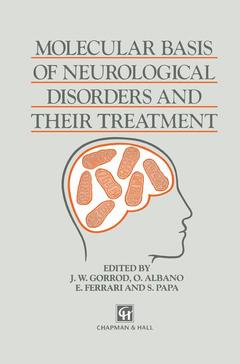Molecular Basis of Neurological Disorders and Their Treatment, Softcover reprint of the original 1st ed. 1991
Langue : Anglais
Auteurs : Gorrod J.W., Albano A., Ferrari E., Papa S.

cytochemical techniques (ICC) which provide a useful adjunct to investigations by immunoblotting. A particular advantage of a cytochemical approach to the investiga tion of mitochondrial disorders is that it allows the mosaic distribution of certain of these defects to be detected, whereas the tissue homogeniza tion involved in conventional enzyme assays or immunoblotting precludes this. A further advantage of MEA or ICC is that only small amounts of tissue are needed, which is important since many of the affected patients are infants or small children. The main aim of this communica tion is to outline ways in which these techniques can be used in the diagnosis and further investigation of mitochondrial disorders. Reference will be made not only to those situations in which MEA and ICC offer advantages over standard enzyme asays and immunoblotting but also to contexts in which the reverse applies. 4. 2 MATERIALS AND METHODS Muscle biopsies for cytochemical investigation were snap-frozen using isopentane cooled to - 150°C in liquid nitrogen. Samples were stored in heat-sealed polythene packets in the vapour phase of liquid nitrogen containers. 4. 2. 1 Microphotometric enzyme assays Frozen sections 8 Jlm thick were cut using a Reichert-J ung Frigocut cryostat microtome equipped with motor-driven cutting action to maintain maximal reproducibility of section thickness. Sections were picked up on microscope slides and air-dried for 15 min at room temperature.
1 Towards a molecular model of the acetylcholine receptor channel.- 2 Proton-motive ATP synthase and energy transfer in the cell.- 3 Comparative analysis of the amount of subunit I and subunit IV of the cytochrome c oxidase mRNAs in the cerebral hemispheres of senescent rat and effect of acetyl-l-carnitine.- 4 Cytochemical and immunocytochemical investigation of respiratory complexes in individual fibres of human skeletal muscle.- 5 Native myelin proteins and myelin assembly in the central nervous system.- 6 Regulation of immune cells by serine phospholipids.- 7 Cell adhesion molecules belonging to the immunoglobulin superfamily.- 8 Neurogenic control of cerebral blood vessels.- 9 The fine structural aspects of brain oedema and associated microvascular and glial changes.- 10 Image-guided localized nuclear magnetic resonance spectroscopy of human brain tumours.- 11 Neuroimaging study of frontal lobes.- 12 Biochemical indicators of ischaemic brain damage.- 13 Molecular basis of astroglial reaction to brain injury; regulation of glial fibrillary acidic protein mRNA in rat cerebral cortex and in primary astroglial cell cultures.- 14 Tissue plasminogen activator; acute thrombotic stroke.- 15 Lysosomal storage of a mitochondrial protein in Batten’s disease (ceroid lipofuscinosis).- 16 Leber’s hereditary optic neuropathy; from the clinical to the new biochemical and molecular findings for understanding the pathogenesis of the disorder.- 17 Types and mechanism of mitochondrial DNA mutations in mitochondrial myopathy and related diseases.- 18 Direct tandem duplications of mitochondrial DNA in mitochondrial myopathy.- 19 Mutations of mitochondrial DNA; the molecular basis of mitochondrial encephalomyopathies and ageing.- 20 Analysis of giant deletions of human mitochondrial DNA in progressive external opthalmoplegia.- 21 Biochemical and genetic investigations in eleven cases of mitochondrial myopathies.- 22 Familiar cases of mitochondrial myopathies; mitochondrial DNA deletions and genetic analysis.- 23 The correlation between pathology, biochemistry and molecular genetics in mitochondrial encephalomyopathies.- 24 Various clinical presentation of mytochondriopathies; clinical and therapeutic considerations.- 25 Voltage-gated sodium channels as target for pharmacologic agents.- 26 A K+ channel opener in vascular smooth muscle; pharmacology and mechanism of action of cromakalim.- 27 Molecular and cellular mechanisms involves in high resistance neonatal brain resistance to anoxia.- 28 Metabolic activation and mechanisms of MPTP toxicity.- 29 Neurochemical changes produced by perinatal exposure to lead.- 30 Electrophoretic studies of the interaction of neuroleptic drugs with brain tissue.
Date de parution : 10-2012
Ouvrage de 337 p.
15.5x23.5 cm
Disponible chez l'éditeur (délai d'approvisionnement : 15 jours).
Prix indicatif 210,99 €
Ajouter au panierThèmes de Molecular Basis of Neurological Disorders and Their... :
© 2024 LAVOISIER S.A.S.



